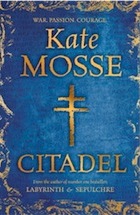 The complex history of the Languedoc has proved fertile territory for Kate Mosse in her recent trilogy of adventure novels, beginning with the phenomenally successful Labyrinth in 2005, shortly to be a mini-series, and now reaching its conclusion in Citadel.
The complex history of the Languedoc has proved fertile territory for Kate Mosse in her recent trilogy of adventure novels, beginning with the phenomenally successful Labyrinth in 2005, shortly to be a mini-series, and now reaching its conclusion in Citadel. |
| Author Kate Mosse |
Mosse has marshalled a large cast of characters, although (as in Labyrinth and its successor, Sepulchre) the story centres around a determined young heroine, in this case 18-year-old Sandrine Vidal, an orphan living with her older sister in Carcassonne. Sandrine is shocked out of her innocence in the summer of 1942 when her life is saved by a young resistance fighter, Raoul Pelletier, just as he discovers that his network has been infiltrated by a spy, Leo Authié, working for the Deuxième Bureau, the French military intelligence agency. When a bomb goes off at a crowded, peaceful demonstration, Raoul realises he has been set up by Authié to look like the perpetrator. He goes on the run, aided by Sandrine and her sister, Marianne, who is already working with the resistance.
But Authié wants Raoul for his own purposes: Raoul is in possession of a map belonging to his former comrade, Antoine, who died under torture at the hands of Authié's henchman without revealing its whereabouts. Beneath his official guise, Authié is a kind of latter-day inquisitor, obsessed with restoring the purity of the Catholic faith; he knows that Antoine corresponded with Otto Rahn, and suspects that before Rahn's death the German passed to Antoine a map revealing the whereabouts of an ancient codex containing a secret so powerful it could change the course of the war. The Ahnenerbe are also pursuing this codex, apparently with Authié's assistance, though to their cost they fail to realise that his motivation for securing it is quite different to theirs.
As in the first two books, Mosse sets up two narrative threads progressing in parallel, though the difference here is that neither concerns the present day. Although the principal story follows Sandrine and her friends as they attempt to find the codex, while evading capture and throwing Authié and his collaborators off the scent, we also glimpse the far distant history of the region in the subplot of the codex's original journey into the mountains, in the hands of a young, fourth-century monk risking death to save the heretical text from the flames.
Though the elements of fantasy and magic require a firm suspension of disbelief (there is a whiff of Tolkien about the alleged powers of the codex), what capture the reader most powerfully are the horrors of the Nazi threat and the sacrifices necessary to survive and resist, which make Citadel feel the most substantial and mature of the trilogy.
Mosse has grounded her story in exhaustive research, as testified by the bibliography, but she wears her learning lightly, keeping the characters and their personal dramas to the fore, switching neatly between perspectives to maintain tension. She has a particular knack for creating vivid action scenes — the blood, debris and panic of a bomb attack, or a skirmish – but she describes with equal precision the small, daily hardships of life under occupation: the endless paperwork, the difficulties of communication, the twitching curtains next door. Fans of the previous two books will be pleased to find characters and themes recurring here, most notably the magus figure of Audric Baillard, the enigmatic scholar who has lived many centuries and seems to embody the resilience of the land and its people.
Citadel is a deeply satisfying literary adventure, brimming with all the romance, treachery and cliffhangers you would expect from the genre. It is also steeped in a passion for the region, its history and legends, and that magical shadow world where the two meet.


No comments:
Post a Comment